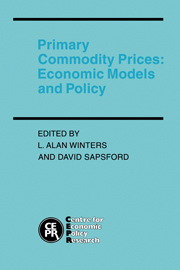Book contents
- Frontmatter
- Contents
- List of figures
- List of tables
- Preface
- List of conference participants
- 1 Primary commodity prices: an introduction to the major policy and modelling challenges
- I ECONOMETRIC ANALYSES
- 2 Estimation of dynamic disequilibrium models with rational expectations: the case of commodity markets
- 3 Modelling expectations formation in primary commodity markets
- 4 The prices of perennial crops: the role of rational expectations and commodity stocks
- II SECTORAL STUDIES: FOODS, MATERIALS AND ENERGY
- III STABILIZATION SCHEMES
- Index
2 - Estimation of dynamic disequilibrium models with rational expectations: the case of commodity markets
from I - ECONOMETRIC ANALYSES
Published online by Cambridge University Press: 05 March 2012
- Frontmatter
- Contents
- List of figures
- List of tables
- Preface
- List of conference participants
- 1 Primary commodity prices: an introduction to the major policy and modelling challenges
- I ECONOMETRIC ANALYSES
- 2 Estimation of dynamic disequilibrium models with rational expectations: the case of commodity markets
- 3 Modelling expectations formation in primary commodity markets
- 4 The prices of perennial crops: the role of rational expectations and commodity stocks
- II SECTORAL STUDIES: FOODS, MATERIALS AND ENERGY
- III STABILIZATION SCHEMES
- Index
Summary
A commodity is something that hurts when you drop it on your big toe, or smells bad if you leave it out in the sun too long.
Barron's, 27 June 1983The aims of this paper are:
(1) to outline some methods of incorporating rational expectations into disequilibrium models;
(2) to discuss the applicability of these methods in the modelling of commodities characterized by market interventions like price supports and buffer stocks; and
(3) to review the usefulness of other sources of price expectations like survey data, futures prices and Bayesian vector autoregressions, if the methods suggested here cannot be implemented.
Sources of disequilibrium
The methodology used for incorporating rational expectations into disequilibrium models depends on the particular sources of disequilibrium. In commodity modelling the sources are the different methods used for price stabilization: McNicol (1978, p. 25), for instance, lists the following types of market intervention.
(1) Purchase alone, with the material held in storage indefinitely or disposed of in a way that does not affect market price.
(2) Purchases coupled with restrictions on supply.
(3) Purchases and sales without any restriction on supply.
(4) Restrictions on supply alone.
(5) Purchases and sales coupled with restrictions on supply.
The US agricultural programs provide examples of the first two. A support price program is one of purchase alone. Soil bank and acreage control come under category (2) since they limit the output.
- Type
- Chapter
- Information
- Primary Commodity PricesEconomic Models and Policy, pp. 21 - 43Publisher: Cambridge University PressPrint publication year: 1990
- 1
- Cited by



